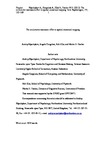The oculomotor resonance effect in spatial–numerical mapping
| dc.contributor.author | Myachykov, A | |
| dc.contributor.author | Cangelosi, A | |
| dc.contributor.author | Ellis, R | |
| dc.contributor.author | Fischer, MH | |
| dc.date.accessioned | 2016-06-02T12:09:42Z | |
| dc.date.available | 2016-06-02T12:09:42Z | |
| dc.date.issued | 2015-10 | |
| dc.identifier.issn | 0001-6918 | |
| dc.identifier.issn | 1873-6297 | |
| dc.identifier.uri | http://hdl.handle.net/10026.1/4803 | |
| dc.description.abstract |
We investigated automatic Spatial-Numerical Association of Response Codes (SNARC) effect in auditory number processing. Two experiments continually measured spatial characteristics of ocular drift at central fixation during and after auditory number presentation. Consistent with the notion of a spatially oriented mental number line, we found spontaneous magnitude-dependent gaze adjustments, both with and without a concurrent saccadic task. This fixation adjustment (1) had a small-number/left-lateralized bias and (2) it was biphasic as it emerged for a short time around the point of lexical access and it received later robust representation around following number onset. This pattern suggests a two-step mechanism of sensorimotor mapping between numbers and space - a first-pass bottom-up activation followed by a top-down and more robust horizontal SNARC. Our results inform theories of number processing as well as simulation-based approaches to cognition by identifying the characteristics of an oculomotor resonance phenomenon. | |
| dc.format.extent | 162-169 | |
| dc.format.medium | Print-Electronic | |
| dc.language | en | |
| dc.language.iso | eng | |
| dc.publisher | Elsevier BV | |
| dc.subject | Attention | |
| dc.subject | Embodied cognition | |
| dc.subject | Eye movements | |
| dc.subject | Oculomotor resonance | |
| dc.subject | Ocular drift | |
| dc.subject | SNARC | |
| dc.title | The oculomotor resonance effect in spatial–numerical mapping | |
| dc.type | journal-article | |
| dc.type | Article | |
| plymouth.author-url | https://www.ncbi.nlm.nih.gov/pubmed/26398486 | |
| plymouth.volume | 161 | |
| plymouth.publication-status | Published | |
| plymouth.journal | Acta Psychologica | |
| dc.identifier.doi | 10.1016/j.actpsy.2015.09.006 | |
| plymouth.organisational-group | /Plymouth | |
| plymouth.organisational-group | /Plymouth/Faculty of Health | |
| plymouth.organisational-group | /Plymouth/Faculty of Science and Engineering | |
| plymouth.organisational-group | /Plymouth/Research Groups | |
| plymouth.organisational-group | /Plymouth/Research Groups/Centre for Brain, Cognition and Behaviour (CBCB) | |
| plymouth.organisational-group | /Plymouth/Research Groups/Centre for Brain, Cognition and Behaviour (CBCB)/Brain | |
| plymouth.organisational-group | /Plymouth/Research Groups/Institute of Health and Community | |
| plymouth.organisational-group | /Plymouth/Research Groups/Marine Institute | |
| dc.publisher.place | Netherlands | |
| dcterms.dateAccepted | 2015-09-08 | |
| dc.identifier.eissn | 1873-6297 | |
| dc.rights.embargoperiod | Not known | |
| rioxxterms.versionofrecord | 10.1016/j.actpsy.2015.09.006 | |
| rioxxterms.licenseref.uri | http://www.rioxx.net/licenses/all-rights-reserved | |
| rioxxterms.licenseref.startdate | 2015-10 | |
| rioxxterms.type | Journal Article/Review |


